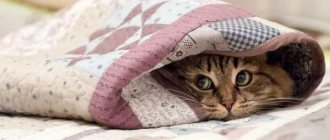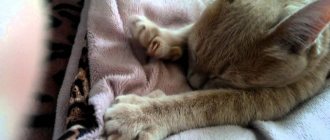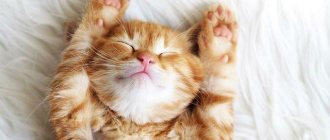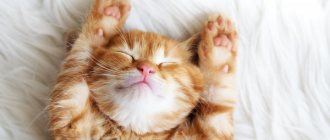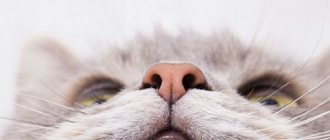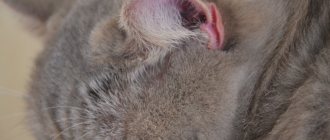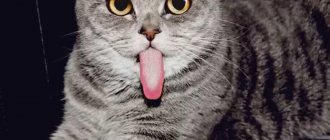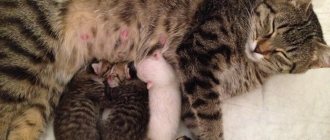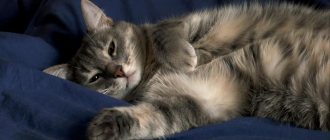8606Administration
3
Any cat lover who has these beautiful creatures living in his home has no doubt noticed how they actively trample with their front paws, diligently massaging their bedding, blanket, or the owner himself. Why a cat tramples with its front paws is of interest to many. There is not a single version that answers this question. They all talk about the natural instincts inherent in the pet from birth.
Having learned more about them, the owner will better understand his furry pet and explain to himself why the cat tramples with its paws. This will allow you to establish the closest relationship with the cat, which will make living in the same house especially interesting.
© shutterstock
A number of false explanations for the seemingly unusual behavior of a pet that tramples with its front paws, and if the owner is guided by them, then he will not be able to understand his pet. In such situations, there is a chance that the relationship with the animal will become strange, and the cat will receive chronic stress from feeling vulnerable and helpless.
It is also unacceptable to punish an animal for its natural behavior, even if the cat is trampling and accidentally stuck its claw at the owner. This is tantamount to scolding a person because, being cold, he begins to shift from foot to foot and shudder. There is an answer to how to change the pet’s behavior if it begins to displease you without causing psychological trauma to the cat. Several recommendations are given in this article; all that remains is to choose one method that is suitable for a particular situation.
When the phenomenon is observed
The owner most often observes the peculiar behavior of a domestic cat when the animal is in a peaceful and calm state. At this moment, the pet may purr. Some cats perform the ritual without releasing their claws.
Other individuals can crush the soft surface, extending their claws to their full length. At the same time, the animal looks concentrated, the reaction to external stimuli becomes minimal. Some owners compare this state of their pet to nirvana.
Many cat breeders note that the cat ritual usually takes place on a soft and pliable surface: a blanket, a mattress, the owner’s lap. A hard surface is not suitable for such purposes. Often the “milk step” is used in relation to a soft toy.
Most often, a cat crushes a soft object with its paws when it is about to rest or sleep. Expectant mothers begin to prepare the nest for childbirth and offspring, often before an important event they begin to knead the blanket with their paws. Pets love to perform such a mysterious action when they are on the lap of their beloved owner. Fans of cats note that a cat performs such a ritual only with its owner; such affection is not available to a stranger.
To learn about what a “milk step” is in cats, watch this video:
[custom_ads_shortcode1]
What are the causes of foot trampling?
There are many theories why a cat tramples with its front paws. Some of them do not stand up to criticism, others can be accepted with reservations. Only the cats themselves probably know the real reason.
The origins of this habit are simple. Anyone who has had a cat feeding kittens knows them very well: here she lies on her side, and the kittens, drinking their mother’s milk, all synchronously crush the food source with their small front paws. By pressing on the cat's mammary gland, they stimulate milk production. So kneading with its paws is one of the first instinctive actions of a kitten. His eyes have not yet opened, he can only eat and sleep, he can hardly reach the nipple, but he is already actively kneading it.
By pressing on the cat's mammary gland, kittens stimulate milk production
Newborn kittens do not know how to retract their claws. They will learn to do this only in the third or fourth week. But for another two months they will train to handle them correctly.
In psychology, it is believed that everything comes from childhood. And it's the same with cats. When a kitten suckles from its mother, it not only eats, but also enjoys it and feels protected. Here is the chain: trampled on mom - ate - got pleasure, protection and calmed down - fell asleep. With age, the components “mother” and “ate” are excluded from this chain, but others remain.
Trampling is done by domestic cats, which do not have to think about where to get food, how to find a secluded place to rest, or how to survive. The breed, age, and gender of the animal do not have a significant impact on this habit: these are exclusively individual character traits.
Based on the original source, let's look at the explanations given for the habit of trampling with the front paws.
Desire to play
Absolutely false statement. The animal tramples when it has already played enough and wants to rest peacefully and sleep. Therefore, if you involve your cat in games at this moment, she is unlikely to be happy: she will be offended, leave, or even scratch in indignation. You wouldn't be happy either if you decided to relax with a book, TV, or just take a nap, but you were forced to engage in vigorous activity.
Getting ready for bed
Good explanation. Only this is a consequence, not a cause. That is, cats do not trample because they are getting ready for bed, but simply do it because it feels good. Outdoor cats fall asleep without any trampling.
Desire to mark the owner as property
No. A cat marks you differently. When you return home, saturated with other people's smells, she meets you on the threshold, rubs herself against your legs and thus restores her rights. Cats use their paws to mark territory by strongly scratching the surface (usually trees).
Childhood memories
Animals should not be humanized. The habit of trampling with its paws came from infancy, but the thought is unlikely to enter the cat’s head: “It was so good as a kitten, let me trample with my paws and return to childhood.”
Even if a cat chooses a soft toy as the object of trampling, this does not mean that it remembers itself as a kitten
Stress relief
Animals are stressed. Trampling with your paws relieves tension. If you watch your pet, you will notice that the intensity and duration of such trampling depends on his mood. Sometimes the cat actively stomps around, nervously twitching its tail, and then gradually calms down and relaxes. Thus, this reason is still an explanation for the cat’s habit of trampling its paws, but not the main one.
Treatment and expression of love for the owner
The therapeutic effect of communicating with animals has been proven. The cat occupies one of the first places in pet therapy, but still, trampling with its paws will not cure diseases, although such a unique massage will not bring harm.
A kind of cat massage will not cure you of diseases, but it will not cause harm either.
Animals first appeared in medical institutions in 1792 in England, in the city of York, in an institution for the mentally ill. Even then, doctors drew attention to the positive effect that cats and dogs have on mentally ill people.
Tatiana Mikhailova
“Cat health from whiskers to tail tip”
Cats are, of course, capable of feeling love and affection for their human. But trampling with the front paws is not a pronounced manifestation of these feelings, because the cat tramples not only people, but also bedding, pillows, toys, dogs, and just air. In general, whatever comes under the paw, they trample.
The cat will happily crush the dog with its paws, if the dog allows it, of course.
Pleasure
But this is the main reason. Cats trample because they like it, they get pleasure. Usually, trampling is accompanied by purring, which also indicates that the animal is in complete harmony with the surrounding world. And also, performing actions that bring pleasure is the credo of any domestic cat.
Probable Causes
Experts in the field of animal psychology identify several reasons why cats knead their paws. This ritual has the following explanations and theories:
It is for this reason that cat breeders call this ritual the “milk step.” Owners often notice that the kitten not only wiggles its paws, but also purrs contentedly and even drools with pleasure. This theory is supported by the fact that artificially fed pets are not capable of the “milk step”.
- One of the reasons why cats paw is their natural instincts. Being once wild predators, animals carefully prepared places for rest and overnight: they trampled down hard grass, making the nest cozy and soft. In the wild, representatives of the cat family use grass and leaves to make a nest. To make your sleeping area comfortable and safe, it needs to be put in order. The most convenient way to do this is to crush objects with your paws.
The desire to equip one’s territory, a place to rest and sleep, is also characteristic of modern domestic couch potatoes. And although most pets live in comfortable conditions, nevertheless, they have not lost the ancient instinct of their wild ancestors. In addition, the cat often crushes soft objects with its paws, arranging a nest for birth and future offspring. Often this behavior is a sign of impending labor.
- Hunting instinct. Some experts believe that domestic cats knead a soft surface, obeying the ancient hunting instinct. Predators by nature, pets have not lost the ancient skills of this skill. Their wild counterparts, before jumping on the prey, crush the surface with their paws, testing it for stability and hardness. It is important for a predator that at a crucial moment a branch does not snap under its paw. Fluffy couch potatoes have not lost their natural instincts, but they do not always use them for their intended purpose.
- Territorial version. Some zoologists are inclined to believe that the reason why cats crush their owners' paws is their desire to mark their territory. There are specific glands on the pads of cats' paws, with the help of which they identify their possessions and territory.
Considering its beloved owner to be its property, the animal leaves its scent on his body, making it clear to other individuals that they can no longer have the right to the owner’s attention. Thus, the ritual serves as a kind of marker to mark one’s property and possessions.
- Psychological release. The psycho-emotional tension or stress accumulated by the pet requires release. Some animal psychologists, not without reason, believe that the reason why cats knead the blanket with their paws is self-soothing. At the same time, the animal practically disconnects from the outside world and focuses on its internal sensations. Monotonous paw movements and purring help calm the pet.
This point of view is supported by the fact that during the “milk step” the cat’s body produces endorphins - specific substances, hormones of happiness. They reduce anxiety and fear in pets.
- Other factors. Experienced breeders believe that the reason for the cat ritual is a high degree of trust and love for its owner. Many cat fans believe that animals perform such a ritual for a healing purpose - they treat their owner from various ailments, taking away negative energy.
Another reason why cats massage their paws is sexual behavior. As a rule, in the spring, with increasing daylight hours, the production of sex hormones increases, which in some individuals is accompanied by a “milk step”. The variety of theories, versions and guesses regarding a peculiar ritual inherent only to representatives of the feline family once again testifies to the mystery and enigma of domestic cats.
None And here is more information about how to remove a cat from a tree yourself and with the help of special services.
[custom_ads_shortcode2]
Video “Why does a cat trample its paws”
From this video you will learn several versions of why cats love to trample with their paws.
Recognition of the owner by mom
When little kittens massage your cat's belly, they increase the flow of milk to the nipples. At these moments, being next to their mother, they feel completely safe, they are warm, nourished and comfortable. Being already adults and feeling security and contentment, they can “fall into childhood” and knead their owner’s knees, like they once did with their mother’s belly.
This version is also supported by the fact that sometimes the “milk step” is accompanied by a quiet smacking of the lips. It has also been noted more than once that animals that are taken from their mother too early exhibit similar behavior more often, as if trying to compensate for what they lost in childhood.
Relieving emotional stress
Some breeders note that the pet may knead the bed or sofa too vigorously and angrily without purring. This often happens after the cat has been offended - they have not given a piece of sausage from the table, scolded, woken up, pushed from a warm place, etc.
In this case, stomping on furniture may mean that your pet is letting out stress. As a rule, such therapy helps and the cat quickly calms down. After this, she often returns to her owners, showing that she is no longer angry with them.
Preparation for sleep
By analyzing the behavior of wild cats, you can get another answer to the question why domestic cats knead the blanket with their paws.
In natural conditions, cats crush grass with their paws to make a bed for resting. According to a number of animal psychologists, this instinct remains with them to this day. Accordingly, before lying down on a blanket or on a person, cats first “trample” them down.
Massotherapy
Some believe that cats conduct a massage session for the sake of the owner himself, thus trying to cure him of some ailment or simply relieving accumulated muscle tension.
You can believe or not believe in the ability of cats to treat diseased organs with the help of energetic influences, but it is clear that massage is beneficial for the body in any case: it improves blood circulation, warms up muscles, promotes relaxation, and relieves stress.
According to some data, a cat’s purring itself has a healing effect: it promotes rapid cell regeneration and wound healing, and reduces the risk of a heart attack.
Owners who have several pets note that many dogs really love cat massage and even endure their claws extended for it.
Other reasons
According to some scientists, cats can crush people or furniture for a number of the following reasons:
- Marital advances. If an adult pet does not have a mate, it can transfer its unrealized sexual instinct to its owners. In this case, the animal will massage the person to express tenderness and receive reciprocal affection.
- Gratitude. Often, cats begin to purr and stomp on the owner’s body after stroking, as if trying to express their love and gratitude.
- Checking the resting place. There are numerous nerve receptors on the pads of a cat's paws that allow them to sense the world around them very subtly. By trampling on knees or a blanket, the animal tests their comfort.
- Production of happiness hormones. According to some studies, cats' purring and stomping stimulates the production of endorphins in their own body. Thus, the animal will purr and knead soft surfaces to improve mood and even correct poor health.
Should I be scolded for such behavior?
Understanding why cats knead the blanket with their paws, the owner should under no circumstances punish the pet for displaying natural instincts. You should be understanding of the complex and peculiar behavior of the cat. Negative emotions, irritating intonations, and being thrown off your knees during the “milk step” can lead to stress and the development of a negative psycho-emotional state. The animal will stop trusting the person and will withdraw from communication with him.
The owner may not like the fact that the cat crumples his body due to the fact that some individuals can release their claws and injure him. In this case, it is advisable to keep a thick towel or small blanket nearby to lay on your lap. This will protect the owner from injury if the cat releases its claws.
You can stop the unwanted action by lightly pressing the cat against a soft surface. She will settle down and calm down. Stroking and gentle intonations will calm the pet, and it will stop kneading the owner’s paws.
The unusual behavior of domestic cats in the form of trampling in one place has a variety of reasons. Most often, a kind of ritual is associated with the natural instincts and psycho-emotional state of the animal. An attentive and affectionate attitude towards the pet at this moment is the only thing required from a loving owner.
Cats are amazing creatures. Despite the fact that they have lived next to humans for many millennia, their behavior sometimes raises questions in us. Many owners of such pets are interested in why cats trample.
What is the reason for these animals moving their paws? What does this behavior mean? How should you behave when a cat crushes its owner or the sofa with its paws?
[custom_ads_shortcode3]
What should and should not be done?
Touching and kneading the owner with its paws is a natural behavior for every furry pet. You can’t blame him for this, just like:
- Punish;
- Use physical force;
- Limit your attention.
If a cat tramples with its paws and at the same time releases claws that scratch the skin or tear clothes, the owners can use the following techniques:
- It is necessary to trim the nails, but not too short;
- You can pet your pet;
- You can place a thick blanket under the cat's paws;
- It is worth lightly pressing on the front paws, which will force the pet to remove its claws;
- You can distract your pet's attention by showing his favorite toy;
- It is recommended to lay the cat on its side, stroking its head.
Massaging and purring a cat is the best manifestation of his attention and love. If you decide to punish your pet for this, you risk ruining your relationship with him forever and causing his aggression.
Expression of satisfaction
People to express love for their cats:
- petting pets;
- scratch behind the ear or under the chin;
- speak kindly to animals;
- play;
- treat pets with treats.
Cats, experiencing true pleasure from their owner's attentions, try to express gratitude and love to their owner. The only way they can express their feelings is by moving their paws. This is how the pet “tells” the owner that he loves him, trusts him and enjoys his company.
[custom_ads_shortcode3]
Establishment of “ownership rights” to the owner or mistress
If a cat crushes a person with its paws, this probably means that this is how he establishes his rights to him. The fact is that on the pads of a cat's paws there are sweat glands, with the help of secretions from which these animals leave odorous marks. The beloved owner becomes an object protected by the cat from those who wish to encroach on him. Being marked as a pet is a special honor, because from now on he will give all the affection and love to the one to whom he has established ownership.
[custom_ads_shortcode1]
What not to do when your cat gets too carried away and shows her claws
If a cat stretches its paws without releasing its claws, then such a massage may even seem pleasant to a person. But what if the animal is too carried away, and its stomping on its knees begins to cause pain to the owner?
Here are some tips to help you gently show your cat that it is best to remove its claws:
- If the animal has released its claws and digs them into the skin, then you can lightly stroke its paw on top . This will cause the cat to retract its claws;
- You can, by stroking your pet, pull him down and lay him down . This will help him calm down and stop stretching his paws;
- You can distract your cat with affection or toys.
Affection from the owner will help distract the cat from letting out its claws.
Under no circumstances, even if your cat's daily exercise causes you pain, do not shout or punish the animal.
You cannot sharply push your pet away from you, drive it off your lap or hit its paws. This behavior can seriously undermine the cat's trust in its owner and even cause it severe stress. After this, the pet may stop cuddling or begin to take revenge, for example, marking territory in the wrong place.
Therapeutic massage session
Cats are not only cute pets, but also healers. They are able to detect illness in the owner. Cats often detect diseases long before humans know about them.
When the animals settle down on their owners, they massage them in an attempt to heal them on their own. In search of an answer to the question of why cats lie on their owner’s body and persistently trample it with their paws, it would be a good idea to be examined by a doctor.
There may be no reason to worry, but it still doesn't hurt to get checked. If the diagnosis does not reveal any abnormalities in the functioning of the internal organs, there will be no harm from a cat massage, because by massaging one or another part of the owner’s body, the cat-stomper stimulates blood flow, which has a beneficial effect on the condition of the tissues.
Some people believe that trampling a cat on the owner's body is a sign of troubles related to his health. You should not take this sign seriously, because, as you know, thoughts are material, and if you persistently think about something, it will come true. If a pet often sits in the same place and begins to knead it, this is just a reason to think once again about its health, but not a reason for serious worries.
[custom_ads_shortcode2]
The benefits of communicating with a cat
Why does a cat trample with its paws?
If the owner knows how to listen to the desires of his pet and feels this subtle emotional connection with him, he can get a significant positive return.
- Stroking the fur reduces stress levels and creates a feeling of relaxation. If you suffer from insomnia, pet your cat for 15 minutes before going to bed. This will calm you down, which will speed up the process of falling asleep and improve the quality of your sleep.
- A responsible owner is not at risk of long-term depression or protracted disorders. It’s enough to feed the cat, pet it, and slowly but surely you come back to life.
- Studies among pet owners have also shown that such people are less likely to feel loneliness and experience loss more quickly.
- Conversations with a domestic animal are no longer strange. And American scientists have proven that cat owners lead a more social lifestyle than people without them.
- The purring and warmth of the cat has a positive effect. And here we are talking not only about the psychological state, but also about the body as a whole. When a cat lies on your body for a long time, it warms it. This in turn lowers blood pressure, relieves muscle spasms, and reduces pain in the affected area.
- A cat massage is the pet’s most sincere attempt to share endorphin hormones (the pleasure hormone). Let it trample you and soon you will feel a surge of joy.
The cat's stomping is inextricably linked with his good intentions. Exchange signs of attention with your pets, and they will thank you for it more than once!
Why does a pet move its paws and purr on the bed or sofa?
These animals do not always choose their owners as objects for pawing. You can often notice that a cat climbs onto a bed or sofa and crumples a blanket or bedspread with its paws. Why is she doing this?
There may be several reasons why cats stomp on the bed. This is probably how pets prepare a place to rest, relieve emotional stress, realize sexual instinct, or leave marks.
[custom_ads_shortcode3]
Preparing a place to rest
Instincts can explain why many cats stomp on the bed before dozing off. The wild ancestors of these animals trampled down grass and leaves before settling down to rest. So they prepared their bedding and checked whether the rookery was comfortable for sleeping.
Pets, who do not need to prepare their own place to rest, do it instinctively. Before falling asleep, many of them trample down the blanket or bedspread.
[custom_ads_shortcode1]
Cat comfort
Often cats move their paws before going to bed; this factor is determined by instincts. Previously, cats survived in the wild, and to make a place for themselves at night, they crushed the grass. This, of course, was not done to test softness, but to disperse insects or snakes that could end up in the thickets and interfere with a peaceful rest. Now domestic cats do this at the level of instincts that are passed on to them genetically.
Now cats sleep in a soft bed, but before they used to knead the grass with their paws.
Stress relief
Some owners of these pets notice that sometimes they sit on the bed or sofa and, frowning, begin to vigorously knead the blanket or bedspread, without making any sounds. This behavior means that the animal is offended or upset by something, and by moving its paws it is trying to get rid of negative emotions.
Cats behave this way, as a rule, after they have been denied a treat, scolded for wrongdoing, unceremoniously woken up, driven away from a heated place, etc. Rhythmic monotonous movements of their paws help them quickly calm down and relieve stress, because, as already noted Previously, they still associate pawing with a feeling of security and peace.
[custom_ads_shortcode2]
How to behave as an owner
While a cat is kneading the human body with its paws, the owner of the animal does not feel entirely comfortable due to the fact that he forgets himself and releases his claws. This, in turn, can bring a feeling of pain, both mild and quite strong.
Under no circumstances should you scold a cat, much less hit it. A loud, menacing voice or a harsh slap can cause misunderstanding and mistrust in a cat. She may begin to avoid the person and become aggressive towards him. Indeed, at the time when an animal tramples its paws on something, it experiences the most tender feelings.
However, you should not endure the pain from claws when in contact with a cat, nor should you turn a blind eye to the fact that the animal can ruin your interior items. The following actions will help minimize the negative consequences of paw trampling:
- Start gently stroking your pet’s paws; after a couple of minutes, the animal will remove its claws, continuing to stomp only on the pads;
- Start stroking your pet more intensively, and then gently lay it on its side;
- Distract your cat from what she is doing. Play with her or hug her.
Having considered the possible reasons why cats begin to knead a person’s body or interior items with their paws, we can see that in the vast majority of cases the animal does not do this because it experiences negative emotions. On the contrary, this is how the pet prepares for rest or shows a trusting attitude towards the owner.
Unrealized sexual instinct
Why do some pets climb onto the bed, stomp on it, arching their backs and meowing loudly? This behavior is probably associated with the beginning of the mating season. You can recognize it by the fact that the cat tramples the sofa or bed not with its front paws, as usual, but with its hind paws, and the cat grabs the bedspread with its teeth.
This usually does not last long; after 10–14 days or with the onset of pregnancy, the fingering of the paws and expressive meowing stops. The male can be caught doing this activity at any time.
[custom_ads_shortcode3]
A little about cat physiology and the reasons for this behavior
Why does a cat lick a person: the main reasons and what it means
Cat massage attracts a lot of interest among pet owners. From a physiological point of view, there is a rational explanation why a pet tramples its beloved owner with its paws.
So, as mentioned earlier, stomping is a way of marking territory. The paws contain a large number of ducts and sweat glands that produce and secrete a special secretion. In addition, the paws of all types of cats are sensitive due to the large number of receptors and nerve endings. It is inherent in nature that animals receive a large flow of information about the world around them in this way.
The results of numerous scientific studies have also shown that during diligent pawing and trampling, the pets’ body begins to actively produce endorphin - the hormone of happiness, which allows you to relieve stress, calm down and, of course, relax.
Ancient Egyptian painting featuring cats
Animal marks territory
When cats trample on the couch, they may be trying to secure sole ownership of the bed. Why did the cat need furniture? On the pads of their paws there are sweat glands that secrete special odorous substances, with the help of which these animals mark the territory so that rivals do not lay claim to it. Probably, appreciating the comfort and softness of the bed for rest and wanting to sleep on it all the time, animals try to make their desire obvious to others by moving their paws.
[custom_ads_shortcode1]
